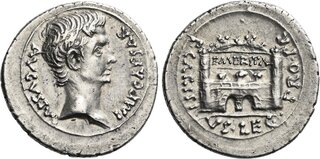| Numismatica Ars Classica > Auction 143 | Auction date: 7 May 2024 |
| Lot number: 443 Price realized: This lot is for sale in an upcoming auction - Bid on this lot  | Show similar lots on CoinArchives Find similar lots in upcoming auctions on |
| Lot description: The Dioscuri Collection. The Roman Empire. Octavian 32 – 27 and as Augustus, 27 BC – 14 AD. Emerita P. Carisius. Denarius circa 25-23 BC, AR 20 mm, 3.44 g. IMP CAESAR – AVGVSTV Bare head r. Rev. P CARISI – VS – LEG PRO PR Circular city-wall with EMERITA inscribed above gate. C 397. BMC 292. RIC 10. CBN –. Very rare and in exceptional condition for the issue. Unusually well struck on a very broad flan and complete. Extremely fine Ex Gorny & Mosch 114, 2002, 207 and Helios 4, 2009, 204 sales. From the A. Lynn collection. The reign of Augustus marked the end of decades of civil war that had been tearing the Roman Republic apart since the early first century BC, the stabilisation of the borders of the Empire, and the institution of the so-called Pax Romana. All of this came at a high cost in Roman constitutional terms. All real power became concentrated in the hands of one man, thereby killing the old Republic and essentially establishing Augustus as king-an institution hated by the Romans since the expulsion of Tarquinius Superbus in 509 BC. However, Augustus carefully crafted his regime to give the outward appearance that the Republic lived on in a modified form and that he was in fact nothing more than primus inter pares ("first among equals") or princeps ("first"). His many successes, which were trumpeted in the monumental Res Gestae, included the (negotiated) restoration of the Roman standards captured by the Parthians in 53 BC and the conquest of Noricum and Raetia, and an extensive building program that is said to have taken the brick city of Rome and made it into a glorious city of marble. However, the disastrous defeat of the Roman legions against the Germanic tribesmen at the Teutoburg Forest in AD 9, convinced Augustus that it was necessary to end imperial expansion and consolidate the borders of the Empire. He also suffered numerous setbacks in attempting to establish an heir. Both his long-time colleague M. Agrippa, and his grandsons, Lucius and Gaius Caesar-his respective first and second choices as successors-died too soon, leaving Augustus no other option but to name his third choice, his stepson Tiberius, as his heir in AD 4. Even then, Augustus lived on to guide and develop the principate that he created for another decade before he died as a result of chronic illness or a poisoned fig supplied by his wife, Livia. The reverse type of this denarius celebrates the foundation of the Roman colony of Augusta Emerita in the province of Lusitania in 25 BC. This colony was used to settle veterans of legio V Alaudae, legio X Gemina, and possibly legio X Valeria Victrix who were due to retire from active duty and who had served in the Cantabrian Wars (29-19 BC). Victory in these conflicts marked the end of the two-centuries long Roman conquest of Spain. Augusta Emerita grew to become one of the largest cities of Roman Spain and was established as the administrative capital of Lusitania. The walls of the city are depicted on the reverse with a surrounding legend naming P. Carisius, the legatus Augusti pro praetore in Spain, who led the legions to victory against the Asturians in 25 BC before settling veterans at Augusta Emerita. Estimate: 6000 CHF |  |



